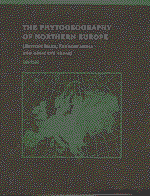Book contents
- Frontmatter
- Contents
- Preface
- Acknowledgements
- 1 Introduction
- 2 Climate
- 3 Edaphic factors
- 4 The geological history of the present European flora
- 5 The atlantic and oceanic elements
- 6 The thermophilic element
- 7 The boreal element
- 8 The arctic, alpine and montane elements
- 9 Endemic, disjunct and centric distribution patterns
- 10 Anthropochorous plants
- Appendix I Calculation of climatic parameters for comparison with plant distributional data
- Appendix II The Northern European species of Flora Europaea with indications of their status and climatic correlations
- Appendix III Arctic species of vascular plants
- Appendix IV Endemic species of vascular plants, bryophytes and lichens
- Appendix V Extra-European disjunctions – bryophytes and lichens
- References
- Index
3 - Edaphic factors
Published online by Cambridge University Press: 23 October 2009
- Frontmatter
- Contents
- Preface
- Acknowledgements
- 1 Introduction
- 2 Climate
- 3 Edaphic factors
- 4 The geological history of the present European flora
- 5 The atlantic and oceanic elements
- 6 The thermophilic element
- 7 The boreal element
- 8 The arctic, alpine and montane elements
- 9 Endemic, disjunct and centric distribution patterns
- 10 Anthropochorous plants
- Appendix I Calculation of climatic parameters for comparison with plant distributional data
- Appendix II The Northern European species of Flora Europaea with indications of their status and climatic correlations
- Appendix III Arctic species of vascular plants
- Appendix IV Endemic species of vascular plants, bryophytes and lichens
- Appendix V Extra-European disjunctions – bryophytes and lichens
- References
- Index
Summary
According to Jenny (1941) the soil at any given locality is a product of parent materials, climate, biota, aspect and time. One should perhaps add still another factor, input from the air, such as sea spray bringing in magnesium and sodium, or particles from desert areas such as the Sahara bringing in calcium. Today we must also add pollutants from human activity as an important pedogenic factor.
In the soil, mineral particles release plant nutrients by weathering. Different primary minerals contain different ions and some minerals are more resistant to weathering than others. By far the most important ion in northern European soils is calcium. It is the major ion that neutralises organic acids produced by the breakdown of litter, and the availability of calcium controls the pH of the soil layers.
The most easily weatherable minerals are calcite and dolomite. Of the silicates, plagioclases, especially calcium-rich plagioclases, some amphiboles, and epidote release calcium relatively easily on weathering. Less weatherable are the pyroxenes, and still less weatherable are the potassium feldspars and quartz. In general, parent materials from basic rocks (that is with a low silicon content) such as amphibolite and gabbro provide better soils than parent material from acid rocks such as granite, acid gneiss and sandstone. Of the micas, biotite provides potassium relatively easily by weathering, whereas muscovite is more resistant. The rate of weathering also depends upon the surface areas of the mineral particles. A fine-grained parent material, for example a clay, provides more nutrients to plants than a coarse-grained sand under otherwise equal conditions.
- Type
- Chapter
- Information
- The Phytogeography of Northern EuropeBritish Isles, Fennoscandia, and Adjacent Areas, pp. 22 - 25Publisher: Cambridge University PressPrint publication year: 1998



